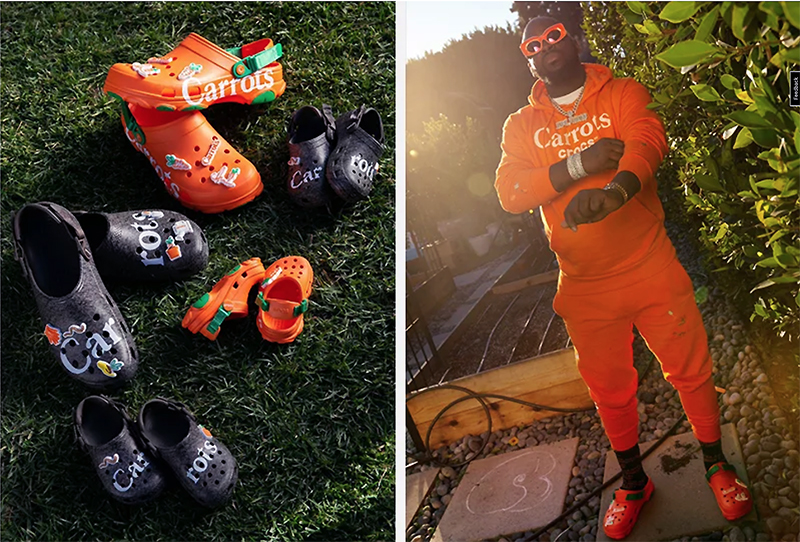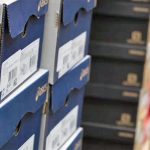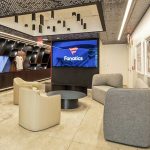Shares of Foot Locker, Inc. shares were down almost 30 percent Friday after the sneaker retailer revealed that a sharp reduction in allocations from Nike would likely result in a high-single-digit decline in comps in the current year. On a call with analysts, Foot Locker CEO Dick Johnson put a smiley face on the news, stressing his belief the retailer will be better off in the long run by offering consumers a greater variety of brands.
“I think that COVID has allowed us all to see the consumer is changing,” said Johnson on the call. “Consumer behaviors are changing. Our consumer is clearly saying that they want choice and that multi-brand destinations matter. And when 75 percent of your purchases are with one vendor, it doesn’t leave a lot of space in your store for choice.”
News of the vendor mix realignment was provided as Foot Locker reported a solid fourth quarter to cap off a record year as store traffic rebounded following a pandemic-depressed 2020. Foot Locker also provided guidance for earnings and sales for 2022 that was well below Wall Street’s targets due to the vendor mix changes.
Nike will remain Foot Locker’s top supplier, but its portion of the business is expected to decline to about 55 percent by the fourth quarter of 2022, down from approximately 65 percent in the 2021 fourth quarter.
The change reflects the accelerated strategic shift to direct-to-consumer (DTC) by Nike as well as Foot Locker’s ongoing brand and category diversification efforts.
For the full year of 2022, Nike products, which includes Converse, are expected to shrink to 60 percent of Foot Locker’s mix, down from 70 percent for 2021 and 75 percent for 2020.
Johnson said Foot Locker would receive less “high heat” or marque product, such as retro Jordans, as Nike flows more marque product to support its expanding DTC business. Said Johnson, “We’ll still have access, we’ll just see fewer units in those SKUs.”
Part of the reduction reflects Foot Locker receiving “elevated access” to some marquee styles over the last two years due to disruptions caused by the pandemic.
However, the significant shift reflects conversations with Nike that took place in late January and was partly “driven by their success with DTC,” said Johnson.
The pandemic has accelerated Nike’s DTC push, driven by substantial online growth but also accelerated stores openings. In its fiscal second quarter ended November 30, Nike’s North America Digital grew 40 percent versus the prior year, pushing Nike Digital to 30 percent of the total North American marketplace and bringing Nike DTC in the region to 48 percent of total sales.
Over the past four years, Nike North America has at the same time consolidated its wholesale account base by roughly 50 percent, including outright exiting a number of chains, including Big 5 Sporting Goods, DSW, Urban Outfitters, Shoe Show, Dunham’s Sports, and Olympia Sports.
Johnson said Foot Locker will “continue to have a strong relationship with Nike and they remain an important partner for our business, especially in basketball, kids and sneaker culture, where we have an unrivaled connection with our consumers.”
While access to marque products will decline, the move should support demand for those styles. He said, “One of the things that Nike does the best is they control the flow of these high heat products into the marketplace, which keeps the demand high. So they will certainly benefit their DTC with some of that, and we will continue to benefit from that.”
He admitted that while Foot Locker would work with other brands to develop hot launch products, “there is nothing like a retro Jordan launch that comes in on a Friday and sells on a Saturday. That’s a tough, dynamic to overcome.”
Still, he said the “biggest benefit” from the vendor mix realignment would be a “broadening” of its styles from Nike well beyond marque and a greater focus on non-Nike vendors.
Indeed, Johnson said the vendor reset also reflects an acceleration of the plan set out on its March 2019 Investor Day that called for adding more diversity to its product mix across brands and categories.
“In the fourth quarter, we saw great vendor diversity with the majority of our top 20 vendors posting gains and driving excitement in their respective categories,” said Johnson. “Not only were we excited by the amount of brands that showed improvement, resulting in non-Nike comp growth is greater than 30 percent; we also remain encouraged by the size of the business we are building with our major partners, which is growing consistently over the years. The momentum of brands like Adidas. Puma, New Balance, Timberland, Ugg, and Crocs during 2021 showcase the expanding breadth of our consumer sneaker closet, covering athletic, outdoor, and seasonal.”

Growth is also expected to come from Foot Locker’s increased focus on apparel and private-label offerings. The apparel category grew 30 percent in the fourth quarter, reaching $1.4 billion in annual sales for the first time in the company’s history.
In December, Foot Locker launched its first private label womenswear brand, Cozi, just two months after the successful debut of its proprietary LCKR men’s wear fleece and casual brand. Johnson said Cozi is “off to a great start.”
In early November, Foot Locker launched All City by Just Don, a lifestyle brand created in partnership with streetwear designer Don Crawley, that has “immediately resonated with the next generation of streetwear enthusiasts.” Foot Locker also continues to employ drops by Melody Ehsani, the company’s creative director of its women’s business “as we expand our offerings and make streetwear more accessible to younger female consumers.”
Looking ahead, he said Foot Locker would “work to further diversify our merchandise and vendor mix, including new brands and elevating brands and categories where we are under-penetrated.”
He called out upcoming collaborations coming from Adidas and New Balance, the success of the exclusive LaMelo Ball range with Puma, the new exclusive partnership with Reebok for the Iverson and Shaq franchises and partnerships with Carrots and Crocs.
Beyond product, growth opportunities for Foot Locker include an accelerated shift to off-mall and rollout of key growth banners. Foot Locker plans to open approximately 300 Global Community & Power Stores over the next three years following the success of the first 50.
WSS, the West-Coast sneaker chain acquired last year, is expected to reach $1 billion in annual sales by 2024, supported by accelerated store openings and anticipated strong same-store sales growth. Atmos, based in Japan, is expected to see sales expand 50 percent to nearly $300 million, over the next three years by scaling in existing markets and expanding internationally.
For the current year, plans call for the opening 100 new stores, including 40 Global Community And Power stores, 27 WSS stores, and nine Atmos stores. In line with its aggressive push for many years to rationalize its store base as leases expire, a total of 190 stores are expected to close. Foot Locker’s store count is expected to decline approximately 3 percent in 2022 with square footage down less than 2 percent.
Other growth opportunities are expected to come from an acceleration of the rollout of dropship across vendors’ banners and regions, effectively creating an endless sale for the consumer while not increasing Foot Locker’s working capital needs, said Johnson. As part of its investment in sneaker resale platform GOAT Group, Foot Locker is discussing creating programs aligned around shared loyalty and membership benefits.
Foot Locker also announced a new cost-savings program designed to generate savings of approximately $200 million on an annualized basis.
However, the newer sales opportunities and expense reductions are not expected to offset the downsizing of Nike in the near term. For the current year, sales are expected to be down in the range of 4 percent to 6 percent. Wall Street had been expecting a gain of 2 percent. The sales decline also reflects tough comparisons against stimulus spending that largely impacted the second quarter of 2021.
Same-store sales in 2022 are expected to drop 8 percent to 10 percent. Wall Street’s consensus estimate had called for a gain of 1.4 percent.
Gross margins are expected to decline 410-to-430 basis points to a range of 30.1 percent to 30.3 percent. Foot Locker said it does not expect the favorable promotional environment and historically low markdowns that persisted in 2021 to continue into 2022. Compared to a more normalized 2019, gross margins are expected to decline 150-to-170 basis points as increased supply chain costs more than offset improvements in product costs.
SG&A for the full year is expected to leverage 30-to-50 basis points, including a partial year benefit from the company’s new cost optimization plan.
Non-GAAP EPS for 2022 is expected in the range to be $4.25 to $4.60, down from $7.77 reported in 2021 and compared to pre-pandemic earnings of $4.93 in 2019. Wall Street’s consensus target had been $6.49
In the fourth quarter, total sales increased 6.9 percent to $2.3 billion, basically in line with Wall Street’s consensus target. Excluding the effect of foreign exchange rate fluctuations, total sales for the fourth quarter increased by 8.2 percent. Fourth-quarter comparable-store sales increased 0.8 percent, with apparel significantly outpacing footwear.
Net income reached $103 million, or $1.02 per share, compared with a net income of $123 million, or $1.17 per share, a year ago. On a non-GAAP basis, the company earned $1.67 per share, including a 20 cent gain from the mark-to-market of one of its minority investments, a 7.7 percent increase from non-GAAP earnings per share of $1.55 in the prior-year period. Adjusted earnings compared with Wall Street’s consensus estimate of $1.47.
For the year, net income totaled $893 million, or $8.61, an increase of 179.5 percent. On a non-GAAP basis, the company earned $7.77 per share, a 176.5 percent increase from non-GAAP EPS of $2.81 in the prior year. Compared with non-GAAP EPS of $4.93 in fiscal 2019, non-GAAP EPS in fiscal 2021 were up 57.6 percent
Fiscal year comparable-store sales increased 15.4 percent. Total sales of $9.0 billion in fiscal 2021 increased 18.7 percent compared to fiscal 2020, and 11.9 percent compared to 2019.
Asked whether Nike’s concentration will head lower than 55 percent, Johnson estimated it could head “slightly lower” to the 50 percent to 55 percent range, depending on factors such as Foot Locker’s success expanding with other vendors and categories as well as Nike’s success with DTC. Johnson said, “If you reflect back to the mid-2000s – 2006 to 2010, that’s about where we were in the mid-40s to upper-50s. And I think we will create a healthier business by spreading our choice for our consumers out to a broader vendor base.”
Photos courtesy Foot Locker
















